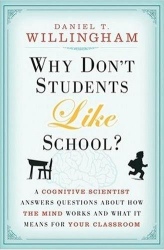 Daniel Willingham is the guy who put learning styles firmly in their place. I greatly respected him for his outspoken, succinct and well put-together YouTube video on the subject and so it was with interest that I spotted Why Don’t Students Like School: a cognitive scientist answers questions about how the mind works and what it means for the classroom.
Daniel Willingham is the guy who put learning styles firmly in their place. I greatly respected him for his outspoken, succinct and well put-together YouTube video on the subject and so it was with interest that I spotted Why Don’t Students Like School: a cognitive scientist answers questions about how the mind works and what it means for the classroom.
Here’s what I learned:
1. Thinking is slow
[T]hinking is slow. Your visual system instantly takes in a complex scene… Your thinking system does not instantly calculate the answer to a problem the way your visual system immiediately takes in a visual scene… [I]f we can get away with it, we don’t think. Instead we rely on memory. Most of the problems we face are ones we’ve solved before, so we just do what we’ve done in the past. (p.5)
2. Curiosity is fragile (p.7-10)
Solving problems brings pleasure… There is a sense of satisfaction, of fulfillment, in successful thinking… It’s notable too that the pleasure is in the solving of the problem. Working on a problem with no sense that you’re making progress is not pleasurable. In fact, it’s frustrating… Mental work appeals to us because it offers the opportunity for that pleasant feeling when it succeeds.
…
[W]hen does curiosity have staying power? The answer may lie in the difficulty of the problem. If we get a little burst of pleasure from solving a problem, then there’s no point in working on a problem that is too easy – there’ll be no pleasure when it’s solved because it didn’t feel like much of a problem in the first place. Then too, when you size up a problem as very difficult, you are judging that you’re unlikely to solve it, and are therefore unlikely to get the satisfaction that comes with the solution.
…
[C]uriosity prompts people to explore new ideas and problems, but when we do, we quickly evaluate how much mental work it will take to solve the problem. If it’s too much or too little, we stop working on the problem if we can. (p.8-10)
3. Cognitive limits should be respected
When trying to develop effective mental challenges for your students, bear in mind [their] cognitive limitations… For example, suppose you began a history lesson with a question: “You’ve all heard of the Boston Tea Party; why do you suppose the colonists dressed as Indians and dumped tea into the Boston harbor?” Do your students have the necessary background knowledge in memory to consider this question? If students lack the background knowledge to engage with a problem, save it for another time when they have that knowledge. (p.15)
4. Background knowledge is necessary for cognitive skills
Not only does background knowledge make you a better reader, but it also is necessary to be a good thinker. The processes we most hope to engender in our students – thinking critically and logically – are not possible without background knowledge.
…
[P]eople draw on memory to solve problems more often than you might expect. For example, it appears that much of the difference among the world’s best chess players is not their ability to reason about the game or to plan the best move; rather, it is their memory for game positions.
…
Much of what experts tell us they do in the course of thinking about their field requires background knowledge, even if it’s not described that way… Unexpected outcomes indicate that their knowledge is incomplete and that this experiment contains hidden seeds of new knowledge. But for results to be unexpected, you must have an expectation! (p.28-32)
5. Memory is the residue of thought
Whatever you think about, that’s what you remember. Memory is the residue of thought. Once stated, this conclusion seems impossibly obvious… Your brain lays its bets this way: If you don’t think about something very much, then you probably won’t want to think about it again, so it need not be store. If you do think about something, then it’s likely that you’ll want to think about it in the same way in the future.
…
The obvious implication for teachers is that they must design lessons that will ensure that students are thinking about the meaning of the material.
…
Trying to make the material relevant to students’ interests doesn’t work… [A]ny material has different aspects of meaning. If the instructor used a math problem with cell phone minutes, isn’t there some chance that my daughter would think about cell phones rather than about the problem? And that thoughts about cell phones would lead to thoughts about the text message she received earlier, which would remind her to change her picture on her Facebook profile, which would make her think about the zit she has on her nose…? (p.47-50)
Willingham goes on to explain that we tend to focus on the ‘personality’ aspects of what makes a good teacher, which is only half the story. The other half is meaning. One of the best ways to convey meaning is to use story structures.
6. Understanding is remembering in disguise
[Students] understand new ideas (things they don’t know) by relating them to old ideas (things they do know).
…
[U]nderstanding new ideas is mostly a matter of getting the right old ideas into working memory and then rearranging them – making comparison we hadn’t made before, or thinking about a feature we had previously ignored.
…
Now you can see why I claim that understanding is remembering in disguise. No one can pour new ideas into a student’s head directly. Every new idea must build on ideas that the student already knows. (p.68-71)
7. Practising is better than drilling
Doing a lot of studying right before a test is commonly known as cramming… If you pack lots of studying into a short period, you’ll do okay on an immediate test, but you will forget the material quickly. If, on the other hand, you study in several sessions with delays between them, you may not do quite as well on the immediate test but, unlike the crammer, you’ll remember the material longer after the test.
…
[Y]ou can get away with less practice if you space it out than if you bunch it together. Spacing practice has another benefit. Practice… means continuing to work at something that you’ve already mastered. By definition, that sounds kind of boring, even though it brings cognitive benefits. It will be somewhat easier for a teacher to make such tasks interesting if they are spaced out in time. (p.90-91)
8. Experts have abstract knowledge of problem types
Experts don’t think in terms of surface features, as novices do; they think in terms of functions, or deep structure.
…
We can generalize by saying that experts think abstractly… Experts don’t have trouble understanding abstract idas, because they see the deep structure of problems.
…
[E]xperts save room in working memory through acquiring extensive, functional background knowledge, and by making mental procedures automatic. What do they do with that extra space in working memory? Well, one thing they do is talk to themselves.
…
What’s interesting about this self-talk is that the expert can draw implications from it… [E]xperts do not just narrate what they are doing. They also generate hypotheses, and so test their own understanding and think through the implications of possible solutions in progress. (p.101-104)
9. Learning styles theory is subject to ‘confirmation bias’
[T]he visual-auditory-kinesthetic theory seems right [because of] a psychological phenomenon called the confirmation bias. Once we believe something, we unconsciously interpret ambiguous situations as being consistent with what we already believe… The great novelist Tolstoy put it this way: “I know that most men, including those at ease with problems of the greatest complexity, can seldom accept the simplest and most obvious truth if it be such as would oblige them to admit the falsity of conclusions which they have proudly taught to others, and which they have woven, thread by thread, into the fabrics of their life.” (p.121)
10. Beliefs about intelligence are important
In a classic study on the effect of praise, the experimenters asked fifth graders to work on some problems in which they were to find patterns. The first set of problems was fairly easy to that the students would solve most of them. The students were then praised for their success. All were told, “Wow, you did very well on these problems. You got [number of problems] right. That’s a really high score.” Some were then told, “You must be smart at these problems.” In other words, the were praised for their ability. Others were told, “You must have worked hard at these problems,” thus receiving praise for their effort. Each student was then interviewed by a different experimenter to learn what the students thought about intelligence. The results showed that those who had been praised for their ability (“you’re smart”) were more likely to describe a fixed view of intelligence than those who were praised for their effort (“you worked hard”), who were more likely to describe a malleable view of intelligence. Similar effects have been shown in many studies, including studies of children as young as four years old.
Conclusion
The two main things I took away were:
- Practice. Practice. Practice. Get and give feedback. Observe others. Ask questions. Be curious.
- Be careful with the language you use with students – both in terms of representing concepts and in terms of praise.
I’d recommend Willingham’s book wholeheartedly. The nine principles he puts in a table towards the end of the book are worth the price of the book alone. They should be jazzed-up and given to all teachers, everywhere!
Why Don’t Students Like School: a cognitive scientist answers questions about how the mind works and what it means for the classroom



